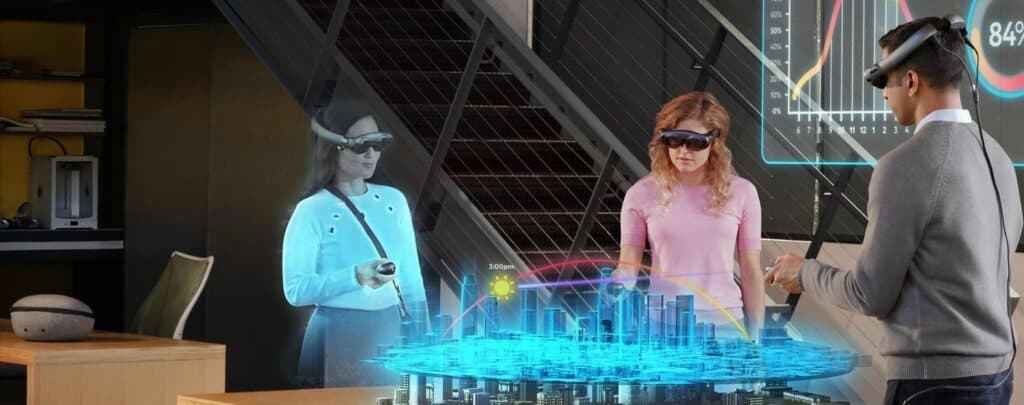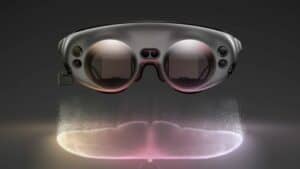There hasn’t been much news on the Mixed Reality front, so it’s good to hear that Magic Leap’s new headset will arrive by the end of this year. After years of promises for devices that incorporate the best of AR and VR, the past two years have been an onslaught of dismal news. Microsoft repositioned their HoloLens as an enterprise device, as did Magic Leap. And the latter went much further, with layoffs of a third of its staff and the exit of CEO Rony Abovitz. All that talk about how Mixed Reality would foster inspiration and creativity, becoming an innovative tool for artists, vanished in lackluster sales and awkward interfaces. To see how low Magic Leap fell since the Magic Leap One release in August 2018, eBay is listing a unit in mint condition for only $800 this week.
In some ways, the idealism got ahead of the technology (which seems to happen frequently in Silicon Valley). At $2K-$3K for devices that made you feel like you were wearing a helmet or thick steampunk glasses, they were never going to see consumer adoption or even wide use in universities. Needless to add, there are still several promising opportunities for these devices in healthcare and engineering, fields with more resources to spend on hardware. But innovative artistic projects were few and far between, with the remarkable Breathe at last year’s Sundance Film Festival feeling like a (pardon the pun) last gasp for the creative side of Mixed Reality.

Vague Details for Magic Leap’s New Headset
At the Future Investment Initiative (FII) in Riyadh, Saudi Arabia, CEO Peggy Johnson didn’t give us many details on Magic Leap’s new headset. Here are the broad strokes of what we do know (from Road to VR): “50% smaller, 20% lighter, with 100% larger field of view.”
Road 2 VR unpacks this further:
Looking at the first-gen Magic Leap headset itself, and not taking into account the compute unit, the 2018 version weighs 316 g, which would make the second-gen device approximately 250 g.
As for FOV, Magic Leap 1 features a 4:3 aspect ratio, and an estimated horizontal FOV of 40 degrees, a vertical FOV of 30 degrees, and a FOV diagonal of 50 degrees. There’s no telling what aspect ratio the next Magic Leap headset will feature, or how the company will effectively market its ‘100% larger’ FOV moving forward; the company only quotes the diagonal FOV of 50 degrees in marketing material.
Here, it’s very likely the company is talking about a 100 percent increase of overall surface area, and not a 100 percent increase of a single spec (re: not going from 40 to 80 horizontal FOV). That would give it around a 55 degree horizontal FOV.
Given that Magic Leap stretched the truth on how they calculated the field of view for the first-gen unit, we’re not really expecting a 100% greater FOV for the gen-2 headset.
No, Magic Leap Won’t Compete Against Apple
We’d love to be optimistic and go with some of the comments on Twitter that see Magic Leap gen-2 headset as a competitor to Apple’s future AR glasses. But Apple is simply too good at consumer products and will blow right past Magic Leap. Apple will have competitors – notably Facebook and companies like Nreal, which is undoubtedly what they are targeting.
It’s happening! We may finally see the @magicleap device everyone’s been waiting for! God knows that market needs some serious competition, especially before Apple comes in and owns the market. https://t.co/lhUrIniZeX
— Anshel Sag (@anshelsag) February 1, 2021
C3: A Future in Enterprise and Remote Work
Much more interesting are some of the ideas coming from Magic Leap on remote work and collaboration. This is a huge need in a pandemic ravaged economy, and while it’s more of a platform instead of device development, a lighter and smaller HMD makes it more likely that people will use it – if you can get the device cost down.

Here’s CEO Peggy Johnson on Magic Leap’s collaboration platform in an IDA Ireland interview (full interview here).
We’re working on an internal app right now that we call C3, which stands for communications, collaboration, and co-presence,” said Johnson, speaking via video meeting from her den at her home in the US. “Those are the things we need to improve a bit more if we’re to continue working in this virtual way. We’re focusing on, sort of bringing to life meetings. Think of this, what we’re doing now, as a 2D meeting, we want to develop 3D meetings, where people will actually be sitting in the same room as you, but virtually. (Next Reality)
This is where Magic Leap could excel. Zoom is good at communication, but there’s little sense of co-presence in security camera style videos. Many of the virtual world platforms emphasize co-presence but you feel like you’re playing the 60s Milton Bradley game Twister when it comes to collaboration.
Of course, with Magic Leap’s new headset focused on enterprise, don’t expect to see an application for consumers (or educators) over the next few years. But of all the companies out there, Magic Leap has done remarkable work with avatars, and they could easily capture a segment of the high-end collaborative work environment. There’s a real need for a platform that hits all three of the C3 components – communication, collaboration, and co-presence.
Can Magic Leap deliver on the promise of Mixed Reality? We’re not counting them out, but we need to see a significantly better headset before we take another sip of the spatial computing kool-aid.
Emory Craig is a writer, speaker, and consultant specializing in virtual reality (VR) and artificial intelligence (AI) with a rich background in art, new media, and higher education. A sought-after speaker at international conferences, he shares his unique insights on innovation and collaborates with universities, nonprofits, businesses, and international organizations to develop transformative initiatives in XR, AI, and digital ethics. Passionate about harnessing the potential of cutting-edge technologies, he explores the ethical ramifications of blending the real with the virtual, sparking meaningful conversations about the future of human experience in an increasingly interconnected world.

